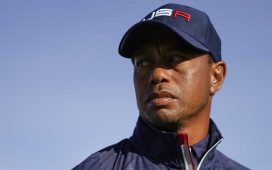There is no bright side to the car accident that Tiger Woods was involved in on Tuesday aside from the obvious one: he is alive. The front portion of the SUV Tiger was driving was crushed, and according to a statement put out late Tuesday night by the Tiger Woods Foundation, the 15-time major winner sustained several severe injuries to his right leg.
“Comminuted open fractures affecting both the upper and lower portion of the tibia and fibula bones were stabilized by inserting a rod into the tibia,” the statement revealed. “Additional injuries to the bones of the foot and ankle were stabilized with a combination of screws and pins. Trauma to the muscle and soft-tissue of the leg required surgical release of the covering of the muscles to relieve pressure due to swelling.”
As of Wednesday, Woods was recovering at Harbor-UCLA Medical Center in Los Angeles. We do not know if Tiger will require more surgeries, how long he will remain in the hospital, what his physical rehabilitation will involve and how long it will be before he can walk.
A return to golf is not the immediate concern for Tiger or his family, and that’s precisely how Rory McIlroy feels it should be.
“Golf is so far from the equation right now,” McIlroy said Wednesday. “It’s not even on the map at this point.”
However, in talking with golf instructors, it is clear that if Woods can get healthy and strong enough to entertain the idea of playing golf again, it will be extremely challenging to rebuild his swing and compete.
McIlroy injured his left ankle while playing soccer on July 4, 2015, which forced him to miss the WGC-Bridgestone Invitational and the British Open that season before he returned to action in mid-August at the PGA Championship. Many golfers think injuring your left ankle (the front ankle for a right-handed player) is worse than injuring your back ankle, but that may not be the case.
“Your feet, ankles and legs are like the foundation of a house,” said Golfweek’s director of instruction, Steve Scott. “If you have a crack in your foundation, your house is going to be compromised.”
Like other golfers, Woods not only turns his shoulders and rotates his hips as he makes his backswing, but he also moves laterally and shifts his weight over his right leg.
“You have to be able to move, shift, turn and support yourself from the ground up,” Scott explained. “And that’s on a flat lie. Golf courses have lots of different terrain like uphills, downhills and sidehills. You have to play bunker shots from the sand.”
All of those situations will put more pressure on a golfer’s feet, ankles and legs than hitting balls from a flat location.
Paul Trittler is the director of instruction at the Grayhawk Learning Center in Scottsdale, Ariz. He said that the challenges for golfers with reduced flexibility in their back ankle and leg don’t end with the backswing.
“Without knowing where all the screws and pins are in Tiger’s foot and ankle, I would guess that the forward swing, the downswing, would be more difficult than the backswing,” Trittler said. “On the backswing, you can take your right foot, put it at a 45-degree to your target line, and that will open your right knee and hip joint, which will allow you to turn more.
“But on the downswing, your back ankle begins to roll as you push off and move to your front side. That could be much more difficult.”
Randy Myers is the director of fitness at the Sea Island Resort in Sea Island, Georgia, and has worked with major winners, like Davis Love and Zach Johnson, as well as 2014 FedEx Cup winner Billy Horschel.
He said that the adjustments golfers with limited flexibility often make can put increased torque and strain on their backs. However, he points out, while Tiger Woods has undergone five back surgeries, the areas that have been repaired are likely stronger now than the rest of his back. New or increased strain, ironically, could affect different parts of Tiger’s back.
“I think this is going to require creating a different swing dynamic for him simply because of the way that he had learned to load with his back injury,” Myers said.
“I can’t emphasize this enough, but even for a 20-handicapper at your local municipal course, you want to surround yourself with the best team, starting with rehab and then post-rehab,” Myers said. “Tiger has an amazing team around him, and with all the technology we have, you can rebuild (your swing) from the ground up more than you could have even 10 years ago.”
For Tiger Woods’ fans, maybe that’s a second bright side to this story.








